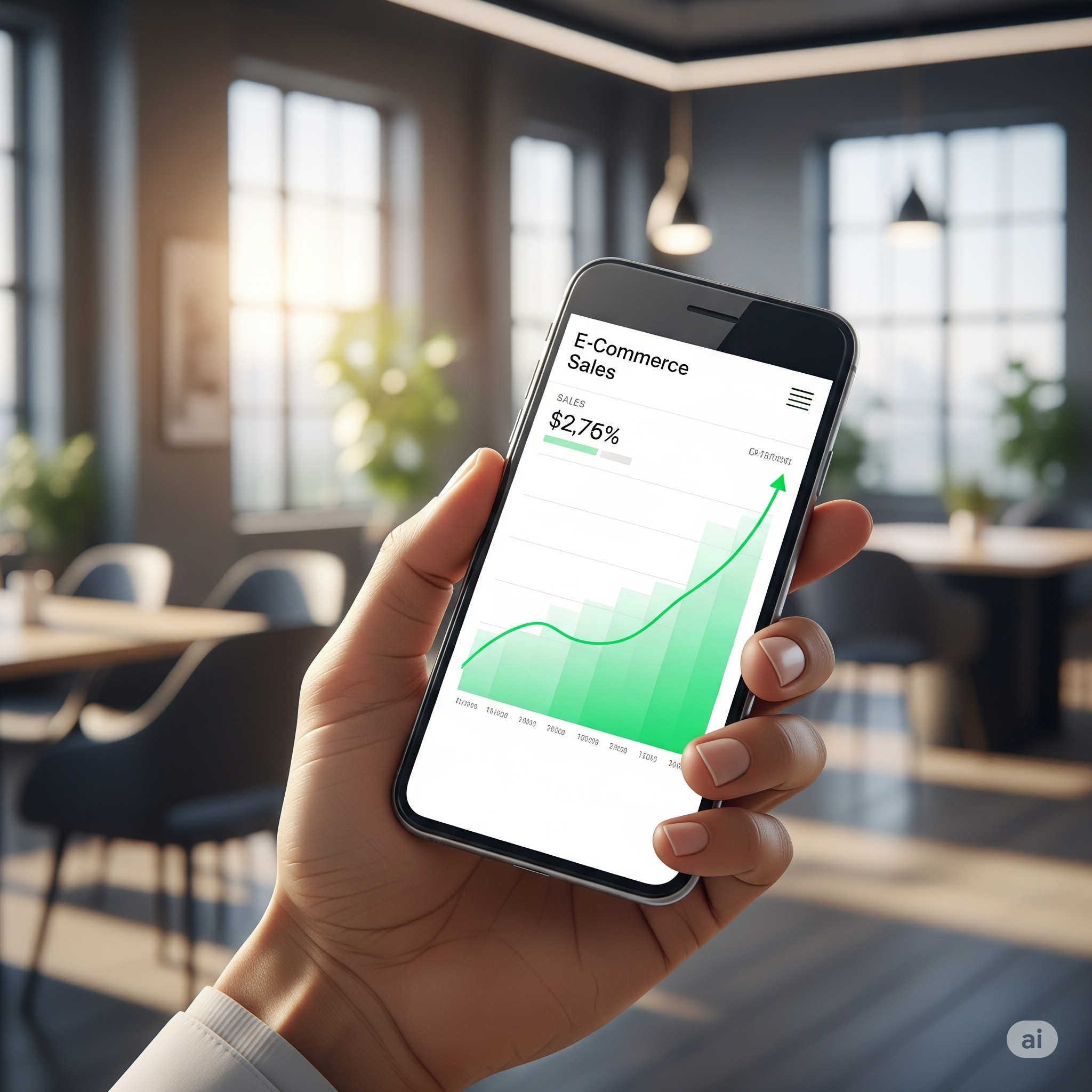📈 Is Your Online Store Not Selling? Boost Your Conversions with These Strategies! 📉
Getting traffic to your online store is only half the battle. The other, more crucial half, is converting those visitors into paying customers. What’s the point of attracting thousands of people if they leave without buying anything? Often, the problem isn’t a lack of interest, but subtle details that go unnoticed: confusing navigation, a complicated checkout process, or a website that takes too long to load.
As a blog editor and writer specializing in technology and e-commerce, with a decade of experience optimizing Prestashop conversion rate optimization and working with other platforms, I’ve seen firsthand how small adjustments can lead to massive gains. In this article, we’ll break down the most common mistakes hurting your possibilities to increase prestashop sales and provide you with practical strategies and optimized technology to transform your online store into a sales powerhouse.
Key Factors Seriously Impacting E-commerce Sales
To understand why your online store isn’t selling, we first need to identify the critical points that directly influence a user’s purchase decision. It’s not just about the product or the price; the entire customer experience is what counts for boosting online store conversions.
1. Load Speed: Every Second Is Gold (or a Lost Sale)
In the digital world, patience is a rare virtue. Users expect a page to load in a matter of seconds. Multiple studies show that if your site takes longer than 3 seconds to load, 53% of mobile visitors will abandon it. This not only means losing a potential sale but also harms your SEO ranking, as Google penalizes slow websites. To dive deeper into how Google evaluates speed, check out Google Developers’ Core Web Vitals documentation.
- Impact on User Experience (UX): A slow website frustrates users, erodes trust, and projects an unprofessional image.
- Impact on SEO: Google prioritizes speed. If your store is slow, it will rank lower than faster competitors in search results.
- Direct Impact on Conversion: Less patience directly translates to fewer visitors completing the purchase funnel.
2. Usability & Intuitive Navigation: Paving the Way for Your Customer
Imagine walking into a physical store where you can’t find anything, the aisles are a maze, and labels make no sense. The same applies online. Complex navigation, unclear categories, or an inefficient search function are huge barriers to conversion. This is fundamental for Prestashop conversion rate optimization.
- Complex or Overloaded Menus: Too many options confuse users.
- Illogical Categorization: If products aren’t organized naturally, customers will get frustrated.
- Ineffective Search: A search bar that doesn’t yield relevant results is as bad as not having one.
- Lack of Filters and Sorting Options: Customers want to quickly refine their search by price, color, size, etc.
3. Unattractive or Incomplete Product Pages: The Core of Your Sale
Your product page is your “star salesperson.” If it’s not clear, appealing, and persuasive, the customer won’t have the information or confidence to buy. This is where a significant part of the sale is decided.
- Low-Quality or Insufficient Images: You need professional photos from multiple angles, and videos if applicable.
- Generic or Valueless Descriptions: Don’t just copy from the manufacturer. Highlight benefits, uses, key features, and address potential questions.
- Missing Technical Specifications: Dimensions, materials, compatibility, etc., are crucial for certain products.
- Absence of Social Proof: Reviews, ratings, and testimonials from other customers are powerful trust magnets.
4. Complicated Checkout Process: The Cart Abandonment Graveyard
This is arguably the most critical point in the conversion funnel. An abandoned cart isn’t an accident; it’s the result of friction in the payment process. Mistakes here are incredibly costly.
- Too Many Checkout Steps: Every extra click is an opportunity for abandonment.
- Mandatory Registration: Forcing users to register before purchasing is a major deterrent. Offer a “guest checkout” option.
- Long and Confusing Forms: Only ask for essential information and facilitate auto-completion.
- Lack of Payment Options: Offer the payment methods preferred by your audience (card, PayPal, etc.).
- Hidden Costs or Shipping Surprises: Display shipping costs upfront.
5. Lack of Trust and Security: The Invisible Barrier
If a customer doesn’t trust your store, they will never buy. Security is a paramount concern in online shopping.
- Absence of an SSL Certificate: The padlock in the address bar is a basic requirement.
- Unclear Privacy and Return Policies: These must be easy to find and understand. To ensure compliance, you can check resources on GDPR– [General Data Protection Regulation].
- Lack of Contact Information or Customer Support: Not knowing who to turn to if there’s a problem creates uncertainty.
How Technology Can Boost Your Online Store's Performance and Increase Prestashop Sales
Technology isn’t just the foundation of your e-commerce; it’s your ally in driving conversions. Implementing the right solutions can make a world of difference at every customer touchpoint, crucial for increase Prestashop sales and other platforms.
1. Speed Optimization Techniques
Beyond hosting, there are specific techniques your developer or IT team can apply:
- Caching: Stores static versions of your website to load faster on subsequent visits. Essential for Prestashop store optimization and Magento.
- Gzip Compression: Reduces the size of CSS, HTML, and JavaScript files before sending them to the user’s browser.
- Database Optimization: A clean and optimized database improves overall site performance.
- Efficient JavaScript and CSS Usage: Load only what’s necessary and defer non-essential script loading.
2. Personalization & Automation for a Unique Experience
Technology allows you to treat every visitor as if they were your only one.
- Product Recommendations: Based on Browse or purchase history (e.g., “customers who bought this also viewed…”).
- Dynamic Content: Display specific banners or promotions based on the user’s profile.
- Email Marketing Automation: Send abandoned cart reminders, personalized welcome emails, or post-purchase suggestions.
3. Advanced Web Analytics: Understand Your User’s Behavior
You can’t improve what you don’t measure. Analytics tools provide crucial data on user behavior:
- Google Analytics: Indispensable for seeing where your traffic comes from, which pages they visit, how long they stay, etc.
- Heatmaps and Session Recordings (e.g., Hotjar): Allow you to see exactly where users click, how they move their mouse, and how far they scroll. An invaluable tool for detecting usability issues.
- A/B Testing: Experiment with different versions of an element (button, headline, color) to see which converts better.
4. Integrations for Streamlined Logistics & Payments
Technology simplifies complex processes.
- ERP/CRM Integration: Synchronize inventory, orders, and customer data, reducing manual errors.
- Multiple Payment Gateways: Make it easy for customers to pay with their preferred method.
- Shipping Management Tools: Offer real-time tracking and flexible shipping options.
Essential Tools & Strategies for PrestaShop and Magento Conversions
Both platforms are powerful, but they require specific configurations and often modules or extensions to maximize their conversion potential.
For PrestaShop Stores (Prestashop Conversion Rate Optimization):
PrestaShop is known for its flexibility and extensive marketplace of modules. If you have an online store with Prestashop, here are some key tools:
- Caching Modules: Essential. Look for options like “Page Cache Pro” or “Cache Manager” to optimize speed.
- Abandoned Cart Modules: Allow you to set up automatic emails to remind users about pending carts. Popular ones include “Abandoned Cart Reminder” or “Mailchimp Pro” (if you use Mailchimp).
- Reviews & Ratings Modules: Indispensable for social proof. “Product Comments,” “Customer Ratings & Reviews,” or integrations with platforms like Trustpilot or Yotpo.
- Advanced Search Modules: Improve the default search engine. “Instant Search” or “Advanced Search” offer real-time filters and suggestions.
- Image Optimizers: Modules that automatically compress and optimize your images to reduce load time.
- Checkout Customization: Modules to simplify the payment process to one or two steps. Look for “One Page Checkout” or “Simple Checkout.”
- Exit-Intent Pop-ups: Modules that display an offer or newsletter signup just before the user leaves the page.
Success Story: Mobileadds (PrestaShop B2B Store) A clear example of PrestaShop’s power for conversion in complex environments is the Mobileadds project. A B2B store was developed on PrestaShop with specific solutions for businesses: integrating payment and shipping systems, custom discount logic, and inventory management via API for products and orders. Additionally, a multilingual and multi-currency system was implemented for a global experience. These advanced functionalities not only optimized internal operations but significantly streamlined the purchasing process for B2B clients, removing friction and boosting transactional efficiency.
For Magento Stores (Magento Optimization for Sales):
Magento (especially Magento 2) is a robust platform, ideal for high volumes and complexity, but it also requires attention to optimization.
- Cache and Performance Extensions: Vital for demanding Magento 2. Look for “Full Page Cache” (comes with Magento Commerce) or third-party extensions like “Amasty Full Page Cache” or “Mirasvit Full Page Cache.”
- Database Optimization: Extensions that help clean and optimize the Magento database for better performance.
- Abandoned Cart Recovery Modules: Similar to PrestaShop, these extensions automate cart reminders.
- Reviews & Ratings Extensions: For example, “Yotpo Reviews & Ratings” or “Trusted Shops.”
- Enterprise Search Engines: Magento can integrate with more powerful search solutions like Solr or ElasticSearch for faster, more relevant results.
- One Step Checkout Extensions: Essential for simplifying Magento’s complex default checkout.
- Image Optimizers: Extensions that automate image compression and resizing.
Success Story: Carhartt (Magento 2 Migration) The migration of Carhartt’s online store from Magento 1 to Magento 2 is a testament to how technological evolution directly impacts conversion. The project involved not only developing a new, modern, and optimized frontend for a seamless user experience but also migrating all order data. This resulted in a more secure, efficient e-commerce platform that was, crucially, better prepared to provide superior customer service, leading to fewer pain points and more sales.
Conclusion: Convert More and Grow Without Limits
If your online store gets traffic but sales aren’t happening, don’t get discouraged. The problem is rarely a lack of interest in your products, but rather barriers in the user experience or technical performance. By focusing on load speed, intuitive navigation, impeccable product pages, a simplified checkout process, and a solid technological foundation, you’ll be laying the groundwork for a highly profitable online store.
Implementing these strategies and tools, especially if you manage an online store with Prestashop or Magento, will allow you to not only solve current issues but also prepare to increase prestashop sales. The future of your e-commerce lies in your ability to convert visitors into loyal customers. If you want to delve deeper into user-centered design, I recommend exploring the principles of Web Usability from Nielsen Norman Group.
Ready to transform your visits into sales and explore what a truly optimized online store can do for your business?
Let’s talk at Snellic.com. Because your next level starts now.
Ready to start your next project?
Do You Need an App for Your Business? Here's How to Know If the Time Is Right
Do You Need an App for Your Business? Here's How to Know If the Time Is Right
Not every business needs a mobile app, but there are key moments when it can truly make a difference. This article explores when a mobile application is the next natural step for your company, what advantages it offers over a traditional website, and what you should evaluate before going mobile.
The Advantages of Mobile App Development vs. a Website
In today’s digital landscape, having a website is essential. But custom app development for businesses offers a new level of interaction, personalization, and performance that websites often can’t match.
Some of the most impactful benefits of mobile apps include:
-
Offline access: Many features can be used without an internet connection.
-
Push notifications: Directly engage users and improve retention with instant alerts.
-
Enhanced user experience: Apps provide faster, smoother, and more intuitive interfaces.
-
Device integration: Apps can access smartphone hardware like the GPS, camera, or biometric sensors.
-
Stronger user loyalty: App users have already shown commitment by downloading—turning them into a more qualified audience.
According to Statista, global mobile app revenues exceeded $400 billion in 2023, proving that mobile is not just a trend—it’s a core strategy for growth.
What Type of Business Needs a Native or Hybrid App?
While any business can benefit from a mobile app, some industries stand to gain more than others:
-
Retail and eCommerce: To enhance shopping experiences and drive conversions.
-
Logistics and delivery: With real-time tracking, route optimization, and customer updates.
-
Health and wellness: For remote appointments, tracking, and personalized recommendations.
-
Education and training: Offering digital learning tools, quizzes, and progress tracking.
Whether you need a native app (built specifically for iOS or Android) or a hybrid app (cross-platform and cost-effective), depends on your goals and user base. At Snellic, we guide our clients through this decision to ensure long-term success. Explore our custom mobile app development services.
Key Signs Your Business Is Ready to Go Mobile
Before jumping into app development, it’s crucial to evaluate if your business is truly ready. Here are some strong indicators:
-
You already have a stable user base or recurring customers.
-
You offer a clear value proposition that can be enhanced through mobile features.
-
Your competitors have apps and are gaining traction with them.
-
You have the internal capacity (or a reliable tech partner) to maintain and scale the app.
-
You’re prepared to invest in both development and user adoption strategies.
Launching an app without a strategic foundation can be a waste of time and money. That’s why Snellic partners with clients not just to build the app, but to shape the product roadmap, define core features, and think long-term.
Success Case: Sealed Air
A standout example of custom app development for businesses is our collaboration with Sealed Air, a global leader in protective and sustainable packaging solutions.
Sealed Air needed a smart tool to help their clients measure the environmental impact of packaging choices. We developed a custom Laravel-based app that:
-
Calculates damage rate reduction benefits for transported goods.
-
Evaluates CO₂ impact across the packaging lifecycle.
-
Provides decision-making insights in a clear, user-friendly dashboard.
This tool is now a vital part of Sealed Air’s sustainability toolkit—demonstrating the power of tech to support both environmental and business goals.
Conclusion
Custom app development for businesses is not just a tech upgrade—it’s a strategic leap. When done right, a mobile app can deepen customer engagement, streamline operations, and position your brand for the future.
But timing matters. Make sure you’re choosing the mobile path for the right reasons—and with the right team.
Ready to explore the possibilities of a mobile app for your business?
Let’s talk. Contact us at Snellic and take the first step toward smarter digital growth.
Ready to start your next project?
What is IT Consulting for Businesses, and How Can It Drive Your Company's Growth?
What is IT Consulting for Businesses, and How Can It Drive Your Company's Growth?
An in-depth look at technology advisory services for companies looking to optimize their digital transformation and internal processes.
In an increasingly competitive market, the businesses that best adapt to technology are the ones that manage to differentiate themselves, optimize resources, and scale faster. This is precisely where IT consulting for businesses comes in: a professional advisory service that analyzes your current digital landscape, identifies inefficiencies, and designs a comprehensive roadmap to take your company to the next level of digital maturity.
1. What Exactly is Technology Consulting?
Technology consulting combines strategy, process analysis, and technical expertise to deliver solutions that directly impact business results. The consultant’s role is to:
- Audit your current infrastructure, software stack, and workflows.
- Identify ‘bottlenecks’ (e.g., manual tasks, incomplete integrations, scattered data silos).
- Propose best-fit tools and methodologies (automation, AI, cloud solutions, e-commerce platforms, CRM, ERP, DevOps, etc.).
- Guide the implementation, tracking KPIs to prove the Return on Investment (ROI).
The ultimate goal is to align technology with your corporate strategy, ensuring that every dollar invested accelerates sales, reduces operating costs, and elevates the customer experience.
2. Key Benefits Your Company Will Realize
| Area of Impact | How IT Consulting Helps |
| Operational Efficiency | Automates tasks like invoicing, inventory, customer support, or marketing. You get more productivity from the same team. |
| Data-Driven Decisions | Real-time dashboards and analytics allow you to act preemptively, addressing issues before they affect the bottom line. |
| Customer Experience | CRM integration and omnichannel strategy personalize offers and boost customer loyalty and retention. |
| Scalability & Agility | Cloud infrastructures and modular development that allow your business to grow and pivot without being limited by legacy systems. |
| Competitive Advantage | Continuous innovation: implementing AI, chatbots, RPA, or marketplaces that your rivals haven’t yet mastered. |
3.Common Use Cases
-
- IT Consulting for Businesses acts as a powerful catalyst across various industries:
- Startups needing a Fast MVP Launch: We design scalable architecture that supports rapid user growth from day one.
- Established E-commerce Sites: Focusing on automating complex logistics, implementing dynamic pricing, or product recommendation engines.
- Industrial SMEs: Transitioning from outdated spreadsheets to a centralized, cloud-based ERP system for better inventory control.
- Service-Based Companies: Requiring a unified CRM to streamline and automate their entire sales process.
In all scenarios, the consultant identifies the ideal technology, calculates the return, and guides the adoption process to ensure a smooth and effective transition.
- IT Consulting for Businesses acts as a powerful catalyst across various industries:
4. Why Choose Snellic as Your Strategic IT Partner?
Demonstrated Expertise (15+ Years)
Based in Barcelona, we’ve powered dozens of successful web, mobile, and e-commerce projects for diverse sectors like retail, pharma, and fashion, consistently delivering custom-tailored solutions.
Multidisciplinary Team
Our internal experts—including Symfony, Laravel, and Angular developers, platform specialists (Magento, PrestaShop, Shopify), UX/UI designers, cloud architects, and digital marketing pros—work in harmony to orchestrate seamless, 360-degree projects.
Focus on Quality and Personalization
Our core values—innovation, quality, and commitment—ensure every line of code aligns with your business goals, and that you receive transparent, close-knit collaboration.
Automation and Data in Our DNA 🧬
We are passionate about replacing manual efforts with intelligent processes: from integrating diverse payment methods to deploying CRMs and ERPs that centralize and control your entire operation.
Projects That Speak for Themselves
LG Electronics, Carhartt Copenhagen, and Superverd are just a few of the clients who rely on Snellic to scale and optimize their digital operations.
Conclusion
Investing in IT consulting for businesses isn’t an expense; it’s a guaranteed investment in efficiency, innovation, and sustained growth. With a partner like Snellic, you get the perfect blend of experience, passion, and strategic focus, ensuring technology stops being an obstacle and becomes your strongest competitive advantage.
Ready to boost your company’s performance?
Contact Snellic today and let’s turn your vision into tangible results.
Ready to start your next project?
UX/UI Optimization: Boost Conversions with Better Design
The Conversion Engine: Leveraging UX/UI Design Optimization to Boost Your Online Business
In the digital realm, your website is your most valuable employee—it’s your shop window, your customer service agent, and your primary sales channel, all rolled into one. However, its effectiveness hinges entirely on one critical factor: the user experience. A site that looks great but functions poorly is a failure. A site that is intuitive, efficient, and enjoyable is a potent conversion engine.
This is the power of UX/UI Design Optimization. It’s not just about aesthetics; it’s a strategic business process that directly impacts your bottom line, dictating whether a visitor stays, buys, or bounces. For businesses serious about standing out in the digital marketplace, partnering with a leading web development agency like Snellic ensures this foundation is built for success.
Understanding the Core Components: UX vs. UI
To truly leverage this discipline, it’s vital to understand its two inseparable components:
-
User Experience (UX) Design: This refers to the process of enhancing user satisfaction by improving the usability, accessibility, and pleasure provided in the interaction with a product or service. UX is about the feeling—ensuring the navigation is intuitive, the information is easy to find, and the user’s journey is efficient and frictionless.
-
User Interface (UI) Design: This focuses on the visual and interactive presentation of the product. UI encompasses the visual elements users interact with: colours, typography, buttons, forms, and the overall layout. UI is the face and the interactive controls that facilitate the excellent experience defined by the UX.
They work in concert: the UI must be visually appealing and functional to serve the underlying strategic flow created by the UX design. A highly effective UX/UI Design Optimization strategy ensures perfect synergy between the two.
The Commercial Value of Optimal UX/UI
An optimized and well-executed design is not an expense—it’s an investment that yields measurable returns:
| Benefit | Impact on Business |
| Improves Usability | Users navigate easily and find information quickly, leading to a reduced bounce rate and increased time spent on site. |
| Boosts Online Conversions | A seamless, attractive, and fluid experience compels visitors to complete desired actions, such as purchases, sign-ups, or demo requests. |
| Fosters Customer Loyalty | Satisfied users are far more likely to return and recommend the site, transforming one-time buyers into long-term customers. |
| Reinforces Brand Credibility | A professional, cohesive, and high-performance design instills immediate trust and confidence in your brand. |
Investing in strategic UX/UI Design Optimization is synonymous with investing in higher sales and greater customer retention.
Strategic Pillars for Next-Level User Experience Design
For businesses seeking to optimize their online presence, a structured approach is essential. Snellic applies several key strategies to dramatically improve the User Experience Design and overall performance of any online business:
1. Deep-Dive User Research and Understanding
Successful design is rooted in empathy. It starts with understanding your audience through surveys, heatmaps, interviews, and behavioural analytics. By identifying user needs, preferences, and “pain points,” developers can design solutions that genuinely resonate and simplify the user’s life. Designing without this research is merely guessing.
2. Visual Consistency and Brand Cohesion
The visual design must be a seamless extension of your brand identity. Utilise an appropriate colour palette, ensure typography is highly legible, and use graphic elements that complement your content. Consistency in UI Design Strategy helps users become familiar with the interface quickly, enhancing navigation and brand recall.
3. Clear and Logical Information Architecture (IA)
Content must be organized logically and hierarchically. A clearly defined site structure makes information retrieval effortless and ensures intuitive navigation. Implementing features like clear menus, descriptive categories, and navigational aids (like breadcrumbs) guides the user at every point in their journey.
4. Speed, Performance, and Technical Optimization
A slow website is a conversion killer. The speed at which your site loads directly impacts user satisfaction and, crucially, Google rankings. UX/UI Design Optimization includes technical practices like image compression, code optimization, and efficient hosting to guarantee minimal load times.
5. Prioritizing Mobile-First and Responsive Design
Given the massive volume of mobile device usage, your site must adapt flawlessly to different screen sizes. A truly responsive design ensures an optimal, consistent experience regardless of whether the user is on a desktop, tablet, or smartphone. This is no longer a luxury—it’s a prerequisite for any modern online business.
6. Accessibility Compliance (A11Y)
Ensuring your site is accessible to people with disabilities is not just a moral obligation; it broadens your market and often improves code quality. Implement features like alternative text for images, keyboard-only navigation options, and appropriate colour contrast, adhering to standard web accessibility guidelines.
7. Continuous User Feedback Loops
Provide straightforward mechanisms for users to offer feedback, such as simple forms or integrated surveys. User feedback is invaluable, providing real-world data to identify areas for improvement and allowing the design to adapt to the audience’s actual expectations.
Case Study in Transformation: BARE Sports Drysuits
A prime example of how professional UX/UI Design Optimization can transform an online business is Snellic’s project for BARE Sports Drysuits. The core objective was to create a platform where customers could easily and efficiently order highly customized drysuits.
The Initial Challenges
BARE Sports faced significant hurdles:
-
Complex Customization: Drysuits require precise, custom measurements for a perfect fit, which made the online ordering process overly complicated and prone to errors.
-
Outdated Interface: The existing website provided a poor user experience, directly contributing to a low conversion rate.
-
Lack of Guidance: Users lacked the necessary tools to confidently determine their sizing and select the appropriate customization options.
Snellic’s Solutions Implemented
To tackle these challenges, Snellic delivered tailored solutions that prioritized the user journey:
-
Custom Sizing Calculator Development: A bespoke tool was integrated, allowing users to input their measurements and receive precise, confident size recommendations for both men and women. This feature significantly simplified the entire customization flow.
-
Intuitive Interface Design: Utilising robust technologies (PHP, Bootstrap, JavaScript), Snellic engineered a fluid and clear platform. The layout, element placement, and visual aesthetic were all meticulously designed to facilitate interaction and maintain brand visual consistency.
-
Streamlined Ordering Process: The purchase flow was completely redesigned to be more direct and understandable, reducing the number of necessary steps and providing crystal-clear instructions at every stage.
Tangible Results Obtained
The implementation of a user-centric UX/UI strategy led to remarkable, measurable results for BARE Sports:
-
Significant Sales Increase: The ease of customizing and ordering drysuits directly led to a higher customer conversion rate.
-
Reduced Cart Abandonment: The new interface and assistance tools helped minimize the number of users dropping out of the complex purchasing process.
-
Improved Customer Satisfaction: Positive feedback validated the improved and notably more enjoyable purchasing experience.
A strong, user-centric design is the definitive difference between stagnation and success in the online world. By implementing these strategies and focusing on genuine user needs, you guarantee a fluid, attractive, and highly effective experience for every visitor.
Ready to stop losing customers to a confusing interface? Partner with Snellic to redefine your UX/UI Design Optimization strategy and unlock your online business’s full conversion potential.
Ready to start your next project?
Scalable eCommerce Development: The Snellic Blueprint
Future-Proof Your Business: The Snellic Blueprint for Scalable eCommerce Development
In today’s fiercely competitive digital landscape, a simple online store isn’t enough. Businesses need a robust, flexible, and scalable eCommerce development solution that can grow with them—not one that caps their potential at the first sign of success. Enter Snellic: a pioneering digital agency based in Barcelona that is redefining what it means to build a future-proof online business.
Snellic has cemented its reputation as a leading expert in web development and the creation of highly scalable online stores. Their approach is unique, centered on business process automation, bespoke software development, and delivering end-to-end eCommerce solutions on powerful platforms like Magento and PrestaShop. They aren’t just designing websites; they’re digitally transforming local and international businesses, giving them the infrastructure they need to dominate their markets.
The Imperative of Scalable Development
Why is scalability the non-negotiable factor in modern eCommerce?
-
Handle Traffic Spikes: Your platform must effortlessly manage seasonal rushes or viral success without crashing, ensuring a seamless user experience (UX).
-
Accommodate Inventory Growth: As you expand your product catalogue, the backend must remain fast, organized, and manageable.
-
Integrate New Technologies: Scalable architecture allows for the easy adoption of new payment gateways, AI-driven personalization, or complex third-party logistics (3PL) systems.
-
Improve SEO & Speed: A well-built, scalable platform is inherently optimized for speed and performance, which is a critical ranking factor for search engines.
Snellic understands this core need. Their focus on custom solutions means the platform is built around your business model, not forced into a generic template.
Innovating with Custom, Performance-Driven Solutions
Snellic’s technological consultancy for businesses in Barcelona begins with a deep dive into a company’s specific digital needs. This isn’t off-the-shelf advice; it’s a bespoke strategy designed to optimize processes and drastically enhance the customer experience.
From implementing sophisticated automated systems to developing secure and highly efficient eCommerce platforms, Snellic ensures every solution is perfectly tailored. Their services are designed to address the complex challenges of modern retail, including:
-
Seamless ERP/CRM Integration: Tying your online store directly to your existing business intelligence tools to centralize data and streamline operations.
-
Custom Checkout Flows: Optimizing the path to purchase to reduce cart abandonment rates—a key performance indicator (KPI) in retail.
-
Internationalization Support: Architecting the store to easily manage multiple languages, currencies, and localized tax/shipping rules, making international sales straightforward.
This level of customization and planning is what sets Snellic apart as an elite web development agency in Barcelona dedicated to delivering truly scalable infrastructure.
Proven Success: Case Studies in High-Growth eCommerce
The effectiveness of Snellic’s commitment to scalable eCommerce development is best illustrated by their portfolio of successful projects:
-
Superverd: Snellic developed a scalable online store for this fruit and vegetable chain. The key achievement was optimizing their inventory and order management system, allowing the business to handle a high volume of perishable goods and rapid delivery cycles effectively.
-
Mobileadds: A sophisticated B2B PrestaShop store was created, simplifying and expediting wholesale transactions. This project demonstrates Snellic’s ability to tackle the unique complexities of B2B sales in an online environment.
-
Jaso Bakery: The team crafted an appealing and highly functional eCommerce platform that blends attractive visual design with advanced features like custom order times and local delivery options, proving that complex logistics can be elegantly managed.
-
Carhartt Copenhagen: For this international brand, Snellic delivered an online store with comprehensive payment and shipping solutions, directly fueling their international sales expansion and supporting a growing global customer base.
These projects showcase Snellic’s versatile ability to adapt advanced technology to the specific commercial needs of diverse clients, consistently delivering tangible and, most importantly, scalable results.
The Snellic Difference: Services That Drive Growth
Snellic’s core service offerings are designed not just to launch a store, but to create a foundation for continuous business growth:
-
Scalable Online Store Development: Flexible, personalized eCommerce solutions built on industry leaders like Magento, PrestaShop, and modern headless architectures.
-
Business Process Automation (BPA): Integrating digital tools to automate redundant operations, freeing up valuable staff time for strategic work.
-
Technology Consulting & Audit: Expert advice and technical deep-dives to improve a company’s existing digital infrastructure and recommend the best path for future expansion.
-
Bespoke Software Development: Creating custom applications and platforms designed from the ground up to solve unique business challenges, giving clients a proprietary competitive edge.
Your Strategic Partner for the Digital Future
The goal at Snellic is far beyond mere website creation. It is about the complete digital transformation of businesses, ensuring they are equipped to thrive and adapt in the volatile current market. By prioritizing innovation, efficiency, and intuitive design, Snellic has become the essential strategic partner for businesses in Barcelona and beyond seeking to leverage the power of the web.
If you are ready to move beyond restrictive templates and invest in a truly robust, high-performance, and scalable eCommerce development solution, the path forward is clear.
Contact Snellic today to discover how their cutting-edge technological solutions can propel your business to its next level of growth and market dominance.
Ready to start your next project?
Los pilares del éxito digital: tecnología, comunicación y diseño
En la era digital actual, las empresas que desean destacar deben abrazar tres pilares fundamentales: tecnología, comunicación y diseño. Estos elementos no solo potencian la presencia en línea, sino que también aseguran una experiencia de usuario única, incrementando la conversión y la fidelidad del cliente. En este artículo, exploramos cómo la combinación de estos pilares puede transformar un negocio, destacando un caso de éxito en desarrollo web en Barcelona.
Tecnología: la base de la eficiencia
El desarrollo web es más que una simple página de inicio. Implica la creación de plataformas robustas, escalables y funcionales que atiendan a las necesidades específicas de cada empresa. Un claro ejemplo de esto es el proyecto realizado para Mobileadds, una tienda B2B desarrollada en la plataforma PrestaShop. Este proyecto incluyó funcionalidades avanzadas como:
- Lógica de descuentos personalizada.
- Integración de sistemas de pago y envío.
- Control de inventario automatizado mediante API de terceros.
- Implementación de sistemas multilingüe y multimoneda.
Gracias a estas soluciones tecnológicas, Mobileadds logró optimizar sus operaciones internas y ofrecer una experiencia de compra adaptada a las exigencias del mercado B2B.
Comunicación: conectar con el usuario
Un sitio web no solo debe ser funcional, sino también comunicar el mensaje correcto de manera clara y efectiva. Esto implica entender las necesidades del público objetivo y reflejarlas tanto en el contenido como en las funcionalidades. En el caso de Mobileadds, se priorizó una navegación intuitiva que facilita la gestión de pedidos y proporciona información precisa y actualizada sobre el stock.
La integración multilingüe y multimoneda también jugó un papel crucial, permitiendo a la tienda comunicarse con clientes de diferentes regiones en su idioma y moneda preferidos. Esta atención a los detalles comunicativos fue clave para mejorar la conversión y fidelización de clientes.
Diseño: la puerta de entrada a la experiencia del usuario
Un diseño atractivo y funcional es esencial para captar y mantener la atención del usuario. En el proyecto de Mobileadds, el diseño se enfocó en la experiencia del usuario (UX), asegurando una interfaz limpia, fácil de usar y adaptada a las necesidades específicas del entorno B2B. El equilibrio entre estetética y funcionalidad es crucial para destacar en un mercado tan competitivo como el de desarrollo web en Barcelona.
Desarrollo web en Barcelona: un centro de innovación
Barcelona se ha consolidado como un referente en el desarrollo web y software. Empresas locales están liderando proyectos innovadores que combinan tecnología, comunicación y diseño. Si buscas soluciones como las implementadas en Mobileadds, ofrecemos desarrollo web en Barcelona, contáctanos ahora para descubrir una amplia gama de opciones para llevar tu negocio al siguiente nivel.
Conclusión
El éxito digital se construye sobre los pilares de la tecnología, la comunicación y el diseño. Proyectos como Mobileadds demuestran que una combinación estratégica de estos elementos puede transformar la forma en que una empresa opera y se conecta con sus clientes. Si necesitas expertos en desarrollo web o desarrollo software en Barcelona, asegúrate de elegir un equipo que comprenda y domine estos tres pilares.







